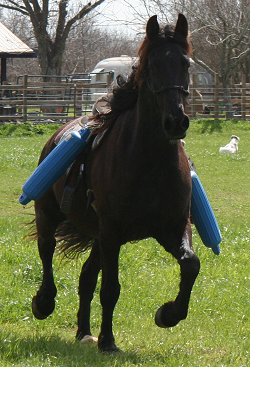 A horse’s first saddle experience can be difficult or easy, depending on how much ground training he has and how solid he is when it comes to pressure situations.
A horse’s first saddle experience can be difficult or easy, depending on how much ground training he has and how solid he is when it comes to pressure situations.
We do not introduce a saddle until a horse can lunge in hand properly and has had a lot of desensitizing. He should have no “untouchable” spots on his body. In other words, you should be able to rub every inch – top, belly, head, ears, tail, fanny – everywhere. He should be able to move around the round pen at each gait, including walking in a relaxed manner when asked.
He should have gone through “plastic bag” de-sensitizing so that objects coming toward him are not frightening. The saddle pad is the next “scary object” to approach him.
Introduce the Saddle Pad
Start this introduction in the middle of the round pen. Bring the saddle and pad from the tack room and stand it on its end in the middle. Walk him around the pile of tack, closer and closer so that he can see it from all angles. Allow him to sniff it and investigate it while it is still and lifeless on the ground.
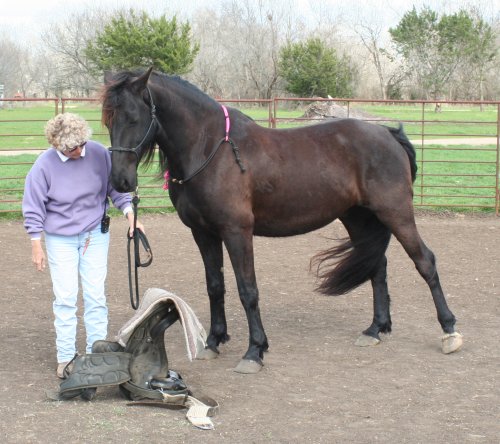
Now pick up the pad.
Holding the pad mid-body high, walk confidently toward him in the middle of the round pen. (Hold the lead draped over your arm so that you can keep his head turned toward you but without any real restraint.)
Let him sniff the pad. He may flare his nostrils, raise his head with wide eyes, back up, snort. None of these reactions usually occur if he is properly desensitized to a lot of other objects. But if they do, just keep the pad steady and walk with him if he retreats. Follow him until he stops, relaxes, then lower the pad slightly to release the pressure. (Avert your gaze so you are not staring him down.)
Now start again. Approach him again, allow him to sniff and investigate. As he gets more confident, you can raise the pad a little. Touch him. Be prepared for him to become alarmed, follow him. Stop when he stops.
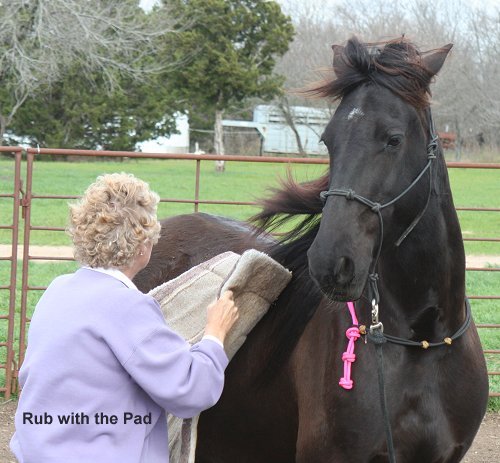
Expand his contact by touching him with the pad, then rubbing him with the pad on his neck and chest. Ultimately rubbing higher up on his side until you can rub him all over.
Move away from his body and start gently tossing the pad around your own body so he gets used to the “John Wayne” approach: less caution – more pad. Come closer and start tapping him with it rhythmically all over his body. Keep a steady rhythm that he can anticipate. Swing, touch. Swing, touch, Swing, touch. Higher and higher until you are letting it land lightly on his back. Let it rest there for longer and longer periods of time.
When he is calm to touch and tolerates the pad sitting on his back, confidently but firmly put the pad on his back without the fanfare. Take it off. Rest. Place it again. Repeat.
Move it back and forth. Rub his back with it. Move it up on his neck. Move it back onto his haunches. Take it off. Put it back on. Repeat several times on both sides.
The colt in the first video is having his very first experience with the pad.
When he is very confident with the pad – that is he stands perfectly still and gives no indication of fear as you toss it on and off – move on to the saddle.
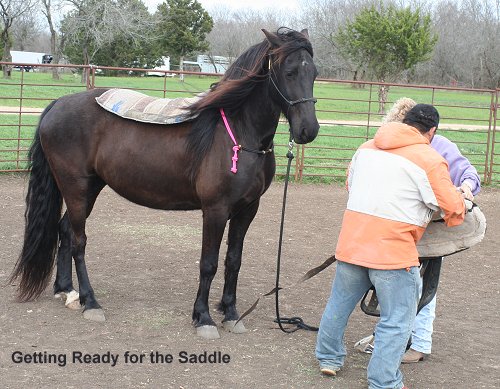
Introduce the Saddle
If he has not had too much trouble with the pad, you may still be standing near the saddle in the middle of the pen. Walk him around it again, closer and closer so that he can see it from all angles again. Allow him the freedom to keep investigating it. Then work through the same procedure that you used with the pad. (You can do all of the saddle de-sensitizing work without the pad at first. A horse with an unsecured pad running backward from a saddle can be hard to work with. If the pad begins to flop or falls off, you will have a potential mess.) With very hot or skittish horses, tie the stirrups and cinch up on top of the saddle so that they don’t flop all over the first few times you place it on his back.
Expand on the approach and placement until you can put it on with cinch and stirrups dangling and flopping. Then with the pad under it. BOTH sides. Then the “John Wayne” flying saddle placement.
The weight of the saddle is rarely an issue. Its placement on his back is rarely an issue. But tightening the cinch can give him a panic attack. I recommend starting the cinch experience as a completely different exercise using your lead rope instead of a saddle.
Simulate the Tight Cinch with Your Lead
Toss your lead over his back and bring it up under his belly so that it wraps around his girth. It will simulate his first girth-tightening.
Step 1: Toss the rope over his back. Rub his belly to let him know you are coming as you reach under to grab the rope on the other side.
Step 2: Tighten and loosen the rope around his girth rhythmically many times, getting tight, then loose, then tight, then loose. Each try gets progressively tighter, longer. If he moves when you tighten the rope, go with him until he stops moving, then loosen it. This is the same as de-sensitizing to any other piece of equipment: approach (tighten) and retreat (loosen) in a steady rhythm until it is old hat. (If you will be using a back cinch, be sure to desensitize him to the pressure further back at the loin too.)
In this video you can see the simulation and then proceed on to more practice sessions with the saddle and pad.
Tighten the Cinch
Now he is experienced at having the saddle placed on his back and having something tightened around his girth. Put the two exercises together.
1. Mount the saddle correctly.
2. Run your hand smoothly and pleasantly (with gentle skin contact) under his chest to reach the cinch on the far side. Bring it to you.
3. Slowly, firmly (but not roughly) pull the cinch tight enough to hold the saddle in place but not “riding tight”. As you do this, have his head turned toward you so that if he moves, it is in a circle and you are out of the kicking zone of his back feet. (the picture is incorrect in this respect). Make the cinch tight enough that the saddle will not fall off or invert if he skitzes away from you. You don’t want it to slip under his belly or get tangled in his legs. But don’t tighten it “riding-tight”.
If he will not tolerate your moving around him while the saddle is sitting on his back, he is not yet ready for the cinch.
Do more saddle-mounting and standing while you walk around him, touch him, rub him.
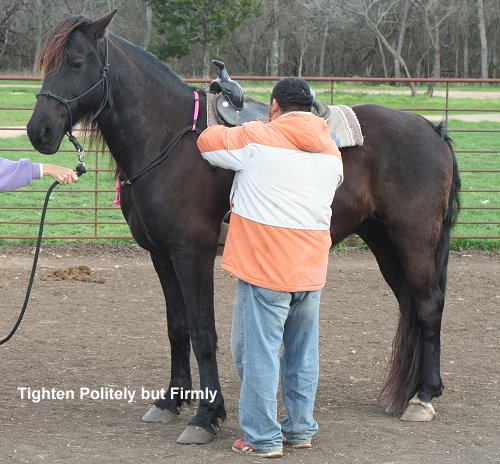
Reign, the horse in the picture, seems to be taking this in stride. However, the proof is in the pudding, and the next step is to begin to flap the stirrups, and do some moving around. Be careful here and stay out of his forward path and kicking path in case he changes his mind about the procedure. It could happen unexpectedly.
Introduce Movement
Take a step or two wearing his new saddle friend? This may present a challenge if you have a hot, nervous Nelly. Moving for the first time with something on his back can make a horse very upset. It sticks to him like a mountain lion. Ask him to take a step or two. Expect that he will walk sideways, trying to see the foreign object on his back. He may “walk on egg shells”.
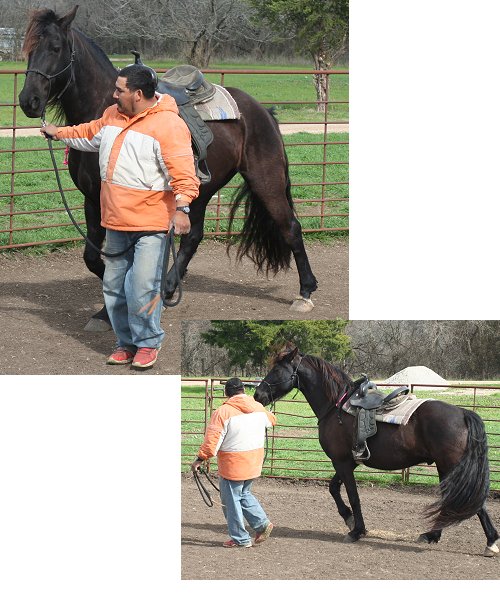
He may get very nervous and start to move faster and faster, building up to a full-blown panic. If he is too much to handle safely while walking near him, either turn him loose and leave the ring, or give him much more lead to move away from you while he is upset. When he calms down, let him relax a few minutes and digest his experience.
If things seem to be going smoothly, ask him to do a routine walking longe. If things stay calm, expect that he might not walk because his nervous energy may induce him to trot. Don’t pressure him, and don’t ask for precision. Let him “come down” on his own. HOWEVER, this is the most common time for the explosion.
Reign went from the calm saddling to nervousness during his first few steps to THIS when he started to move in his longing pattern.
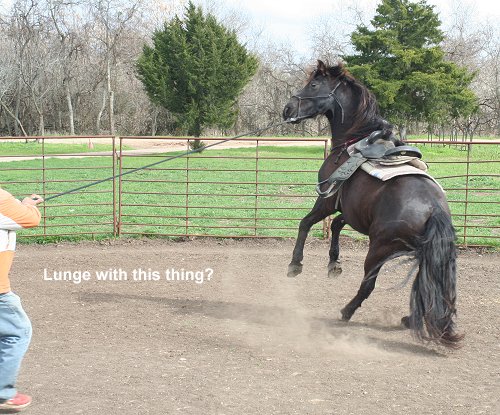
Some horses never buck or get crazy. I would say about 60% of the horses I have trained have not. However, I almost like to see a LITTLE “fight” just because I would rather see it and take care of it on the ground than have him try it with someone in the saddle.
Reign has found out that objecting was useless and took a lot of energy. If you get the horse that goes slightly bananas, be prepared to let him buck it out. Don’t get in his way! (He might buck forward right into you.) If you can hold the rope, you may be able to bring his energy down to a reasonable level fairly quickly. The poll pressure from the halter during Reign’s protest helped to keep him from an uncontrolled bolt and buck experience. However, it is not necessary to hold onto the rope. It IS necessary to be able to get away from him. Turn him loose and stay away from his craziness.
He may need to get through this on his own in the round pen or an arena where he can’t hurt himself or anyone else. Maybe even wear his saddle alone in the pen for half a day – maybe more. This is very rare, but has occurred. THUS the need for an old saddle in case he rubs or bangs it on the fence or rolls on it.
If you get a really frantic, loose horse, watch that he doesn’t mow you down in his efforts to get YOU to save him from the predator on his back. If your ground work has been diligent, he has learned that near you is a safe place. Therefore, in a frantic state, he could actually chase you to get near you.
When his scattered fit is over, proceed. Reign tried this half-rearing-twirling maneuver twice before he settled down to a more controllable state of mind. He remained nervous for the next 30 minutes but did no more flying maneuvers. (You need a round pen with 5-1/2 to 6′ sides if you want to be very sure your horse will not try to jump out.)
Ultimately…he did all of his routine lunging exercises to a satisfactory level during the first 30 minutes of work. After working, we sent him to the pasture wearing his saddle for 2 hours. He had plenty of room to move, buck or whatever. But the green grass was very distracting, and he very quickly forgot the saddle in preference for munching sweet winter rye: a reward for a job well done.
Everything was repeated the 2nd day, and his energy level was much lower.
From this point, for the next 5 hours of training or more, he should do all of his exercises saddled: lunging, backing, disengaging. Gradually tighten the girth to “riding tight”. Expect a little more frantic activity at the new girth pressure, but it should be very short-lived.
Don’t introduce any further ground lessons while he is learning to ignore his saddle. Let him do routine exercises that feel comfortable.
Later: Re-Introduction
This video shows him being saddled again after a 4-month hiatus in his training that required us to back up and do some more de-sensitizing to the saddle with movement. Notice he is nervous when asked to lunge, and he takes off like he was shot. In a few minutes, he settled down, but it is a good example of how speed increases when anxiety increases.
The video is somewhat long, but it is shown in nearly real-time so you can watch all of his reactions.
Under no circumstances should information presented here be construed as veterinary in nature. Always consult your veterinarian if problems persist. Additionally, horse training and equestrian activities in general can be dangerous. While we try to present relevant and valuable content, under no circumstances does horse-pros.com or its members or contributors take any responsibility for the well-being of any horse or person using a method outlined here.
We certainly don’ t know everything. Please share your expertise. Comment on what is already written or Suggest a Category and Educate us about it. Grow Horse-Pros.com©
